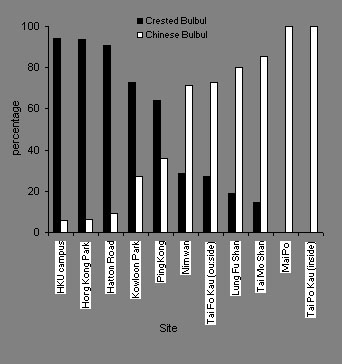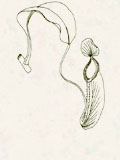
Vertebrates (pdf)
Space partitioning by two common Bulbuls in Hong Kong
by Eric Chan
Introduction
The Crested Bulbul Pycnonotus jocosus (also called Red-whiskered Bulbul) and the Chinese Bulbul Pycnonotus sinensis (also called Light-vented Bulbul) are two of the commonest bird species in Hong Kong. Both of them are residents, and they can be found in a wide range of habitats throughout the region (Carey et al. 2001), including parks, gardens, farmland, shrubland, suburban areas, villages and so on.
According to Gause’s Principle (also known as the Principle of Competitive Exclusion), similar species cannot coexist in the same ecological niche for a long time. However, according to casual observations, the Crested Bulbul and the Chinese Bulbul have long been abundant residents in Hong Kong and co-occur in many of the same habitats, although they both appear to have similar food and environmental requirements. Herklots (1946) and later literature (e.g. Herklots 1953, Herklots 1967, Viney & Phillipps 1977, Viney et al. 1994 and Carey et al. 2001) all described these two species as very abundant in Hong Kong. The life spans for both Crested Bulbuls and Chinese Bulbuls are around eight years; many generations must have passed after so many years of recording, and yet both of them are still very common and seem to coexist in many habitats. This study aimed to compare the ecology of the Crested Bulbul and the Chinese Bulbul, and to explain how both have managed to become so abundant in a small place like Hong Kong.
Methodology
Field observations were conducted from September 2001 to February 2002 to compare the two species. Transect counts were used: a route had been pre-determined in each site, and bulbuls that could be detected visually were recorded during the survey. Eleven sites were chosen in the study (Table 1). The sites cover a number of habitats in Hong Kong, including suburban areas, urban parks, hills and mountains, mangroves, villages and forests. Activities, group size, choice of substrates (e.g. tree branches, concrete ground) and estimated distances of the birds from the ground were recorded.
Table 1. Length of transects and number of visits for each site.
|
Site |
Length of Transect (m) |
Number of Visits |
Habitat Type and brief descriptions of the sites |
|
Hatton Road |
604 |
8 |
Sub urban |
|
Hong Kong Park |
524 |
4 |
Urban park |
|
HKU Campus (near Graduate House) |
542 |
9 |
Sub urban |
|
Kowloon Park |
536 |
5 |
Urban Park |
|
Lung Fu Shan |
1,500 |
5 |
Hill, with secondary forest and rich understorey |
|
Mai Po |
1,600 |
2 |
Mangrove |
|
Nim Wan |
2,856 |
1 |
Mixed habitat, with mangrove, villages and cultivated area |
|
Ping Kong |
1,428 |
2 |
Villages, with cultivated area |
|
Tai Mo Shan |
714 |
3 |
Mountain (the site was at 700m above sea level.) |
|
Inside Tai Po Kau Forest |
4,000 |
5 |
Secondary forest with rich understorey |
|
Outside Tai Po Kau Forest |
1356 |
6 |
The periphery of a secondary forest |
|
Total |
- |
50 |
. |
Result
A total of 451 Crested Bulbuls and 333 Chinese Bulbuls were recorded, and there was no significant difference between their activities, group size, choice of substrate and height above ground (p-values for all comparisons > 0.1). Both species favour trees and shrubs for perching and they mainly stay within 10 m above ground. However, it is striking to find that there was a clear difference in their spatial distribution (Fig. 1). In suburban areas (the small woodland and shrubland near Graduate House on the HKU campus) and urban parks (Hong Kong Park, Kowloon Park), there were a lot more Crested Bulbuls than Chinese Bulbuls. On the other hand, in rural areas including mountains (Lung Fu Shan, Tai Mo Shan), mangrove (Mai Po Marshes) and forest (inside Tai Po Kau Forest), there were a lot more Chinese bulbuls than Crested Bulbuls. In Ping Kong, Nim Wan and outside Tai Po Kau Forest, the differences were less extreme.
Discussion
The behavioural records in the current study suggest that these two species are very similar in their behaviour. Kwok and Corlett (1999) studied birds inside Tai Po Kau Forest, and their results showed that Chinese Bulbuls are a lot more abundant than Crested Bulbuls. Leven (2000) did bird surveys in six different shrubland sites and found that the density of Chinese Bulbuls was higher than that of Crested Bulbuls in all sites. These results are consistent with the current study. The observed space partitioning could simply reflect different habitat requirements by the two species. Alternatively, it could be explained by competition (perhaps for food and nesting sites), with the Crested Bulbul a better competitor in human-modified habitats (Kowloon Park, Hong Kong Park), while the Chinese Bulbul is a better competitor in rural areas (e.g. Tai Mo Shan, inside Tai Po Kau Forest). In sites where a combination of habitats is present (e.g. Ping Kong, Nim Wan), the differences between their abundances are less extreme (Fig. 1). Crested Bulbuls are in general confined to human-modified habitats and absent in forest, probably because it is an introduced species (Dudgeon & Corlett 1994; Leven & Corlett 2004). Swinhoe (1861) clearly stated that no Crested Bulbul was seen in Hong Kong, while the Chinese Bulbul was described as 'an abundant resident'..
No survey in this study was performed during the breeding season (April to August). As differences in breeding requirements can affect their distribution, surveys in the breeding season will contribute to a better understanding of these two species.
 |
| Fig. 1. Relative abundance of Crested Bulbuls and Chinese Bulbuls in different sites. |
Other bulbuls (family Pycnonotidae) that can be seen in Hong Kong include Chestnut Bulbuls Hemixos castanonotus, Red-vented Bulbuls Pycnonotus aurigaster, Black Bulbuls Hypsipetes leucocephalus and Mountain Bulbuls Hypsipetes mcclellandii. Their distributions were also recorded in this study, but the sample sizes are too small to make any representative comparisons. However, there are two points worth noting: (1) Chestnut Bulbuls were only seen inside Tai Po Kau among the 11 study sites. This suggests that this bird is a forest specialist. (2) Five Mountain Bulbuls were recorded inside Tai Po Kau. There was just one disregarded record for this species in Hong Kong previously (Viney et al. 1994). This finding, and the subsequent records (Wild Corner 2003, 2004, Wong 2004, Lewthwaite 2004) for this bird in Hong Kong suggest, that Mountain Bulbuls are now re-colonizing Hong Kong as our forests are becoming more mature.
Acknowledgements
This study is the outcome of my final year project. I would like to express my sincere gratitude to Dr Richard Corlett, who supervised this project and has given me lots of useful comments.
Bibliography
Carey, G.J., Chalmers, M.L., Diskin, D.A., Kennerley, P.R., Leader, P.J., Leven, M.K., Lewthwaite, R.W., Melville, D.S., Turnbull, M. & Young, L. (2001). The Avifauna of Hong Kong. Hong Kong Bird Watching Society. 563 pp.
Dudgeon, D. & Corlett, R. (1994) Hills and Streams: an Ecology of Hong Kong. Hong Kong University Press, 234 pp.
Herklots, G.A.C. (1946). The Birds of Hong Kong: Field Identification. South China Morning Post. 77pp.
Herklots, G.A.C. (1953). Hong Kong Birds. The South China Morning Post. 233 pp.
Herklots, G.A.C. (1967). Hong Kong Birds. The South China Morning Post. 333 pp.
Kwok, H.K. & Corlett, R. (1999) The bird communities of a natural secondary forest and a Lophostemon confertus plantation in Hong Kong, South China. Forest Ecology and Management 130: 227-234.
Leven, M.R. (2000) Shrubland Birds in Hong Kong: community structure, seasonality and diet. Ph.D. Thesis, Department of Ecology and Biodiversity, The University of Hong Kong. 204 pp.
Leven, M. & Corlett, R. (2004) Invasive birds in Hong Kong, China. Ornithological Science 3: 43 – 55.
Lewthwaite, R. (2004). Recent reports (Dec 03 - Feb 04). Bulletin of Hong Kong Bird Watching Society 191: 28 – 29.
Swinhoe, R. (1861) Notes on the ornithology of Hong Kong, Macao and Canton, made during the latter end of February, March, April, and the beginning of May 1860. Ibis 1861: 23-57.
Viney, C. & Phillips, K. (1977). A Colour Guide to Hong Kong Birds. Hong Kong Government Printer. 122 pp.
Viney, C., Phillips, K. & Lam, C.Y. (1994). Birds of Hong Kong and South China. Hong Kong Government Printer. 244 pp.
Wild Corner (2003). Birds. Porcupine! 29: 20.
Wild Corner (2004). Birds. Porcupine! 30: 21.
Wong, C. (2002). The 2002 Breeding Bird Survey - result highlights. Porcupine! 26: 12.
|
|
P.8-9 |
|
Porcupine! |
 Copyright © 2000 |
